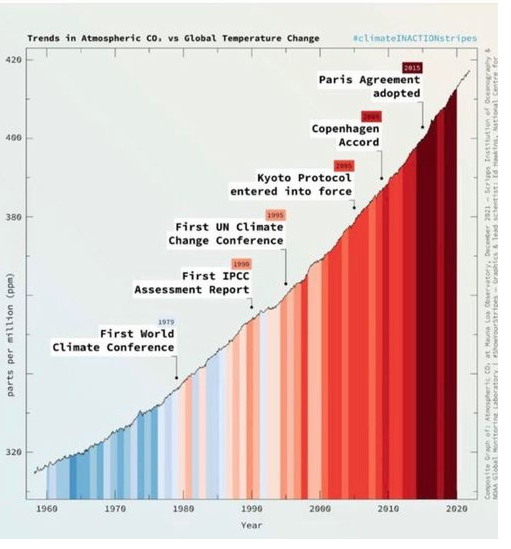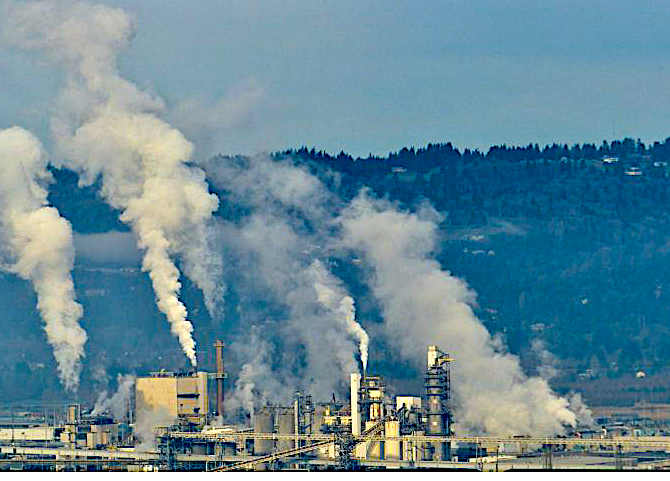CommentsCLIMATE POLITICS - I’ve been in the climate fight for decades. When NASA scientist James Hansen went before the Senate on June 23, 1988 to say global warming is here, it only confirmed what was becoming obvious.
Heating had been picking up for years. From then on, I included climate in my writing and activism on forest preservation and sustainable cities, two movements in which I was active at the time.
I went on the feature climate as a major part of coverage in a very early website, Cascadia Planet, which went live in 1994, and focused my activism increasingly on the climate crisis from around 1996. Over the quarter century since, I have approached the issue from many directions, from writing high-level policy papers and co-authoring a couple of books (here and here), to participating in street-level direct action, even getting arrested a couple of times. I’ve helped grow a couple of climate groups and spur major federal energy research investments. I even was a defendant in a precedent-setting trial where we argued the first climate civil disobedience necessity defense in a U.S. courtroom.
So after all these years, it grieves me deeply, as it does so many others, to see climate action falling short at all levels even as climate disruption intensifies. In fact, it seems that in the past seven years, the hottest in recorded history, the Earth has flipped into a new climate regime. Extremes including storms, floods, heat waves, droughts, wildfires and polar ice loss are surging. A report by the United Nations Intergovernmental Panel on Climate Change released last August confirmed this acceleration. But climate action is now stalled in Congress, and the requisite sense of urgency is lacking.
Even more grievous is the prospect that the limited progress we have made in the U.S. will be rolled back, at least at the federal level. As I wrote last week, the entire federal framework limiting power plant and vehicle climate pollution, the basis of U.S. participation in the Paris Climate Accord, appears threatened with likely Republican takeover of Congress after 2022 and the White House after 2024. As does continued U.S. participation in the global climate process.
Knowing such bleak prospects are not the best to inspire action, I always look for the slivers of daylight poking through the dark clouds. So in my post I pointed to the history of climate action from the local and state level, and the prospects to achieve real progress closer to where we live. My reality sense forces me to see those clouds. It also forces me to ask whether there’s enough daylight. Will the avenues available to us be enough to meet the climate challenge? Can we get there from here? These are the questions we must ask.
Oil and gas leasing: All sides of their mouth
The last post drew a number of interesting responses from social media channels. (I would love to see more in the comments strings.) They centered around deep skepticism regarding the global climate framework and Biden Administration policies. There’s plenty of reason for that.
For one thing, Biden is clearly going in the wrong direction on federal oil and gas leasing. Many called that out. In November, the administration held a record-breaking sale of oil and gas leases in Gulf of Mexico waters twice the size of Florida. Potential impact was up to 600 million tons of climate pollution. The administration claimed a court order mandated it, but that was contradicted by its own internal analysis. In January, a federal judge threw out the leases because the administration did not consider the climate impacts.
Also last year, the administration approved 3,557 drilling permits on federal lands, 34% more than the Trump Administration in its first year. The administration claims it is on shaky legal ground barring drilling on lands already leased to fossil fuel companies, despite a Biden campaign promise to stop new drilling. Environmentalists assert he could do more with executive action ordering further environmental review.
“Every indication is they have no plans of actually fulfilling their campaign promise,” Food & Water Watch policy director Mitch Jones said.
“Biden’s runaway drilling approvals are a spectacular failure of climate leadership,” said Taylor McKinnon at the Center for Biological Diversity. “Avoiding catastrophic climate change requires ending new fossil fuel extraction, but Biden is racing in the opposite direction.”
Biden is only following in the path of his former boss, Barack Obama, whose “All of the above” energy policy was more like “All sides of my mouth.” Speaking to a Houston audience in 2018, Obama claimed credit for thr oil and gas boom under his administration, when oil production increased 88%, much of it from fracking. “ . . . it went up every year I was president . . . America’s like the biggest oil producer and the biggest gas . . . that was me, people.”
Actions by two Democratic administrations to promote fossil fuels run contrary to a 2021 assessment by the International Energy Agency – New oil, gas and coal development must stop to stay within the 1.5°C limit beyond which already severe climate impacts dramatically accelerate. As activists have been saying for years, we must keep it in the ground.
Liberal reformism vs. radical necessity
That leads to the second major area of skepticism I heard in the comments on my last post, whether in the face of such performance the national and global climate frameworks instituted under Obama and restored under Biden are truly meaningful. Might actions that make it appear we are adequately responding to the crisis, when we are actually continuing the slide into catastrophe, depress the sense of urgency needed to generate actions that truly rise to the crisis?
This gets to the most profound question with which climate advocates must grapple, incrementalism versus radical change. In my years working on climate I’ve constantly been stretched between those poles. Most of the climate movement operates in a liberal reformist model, making changes within what is seen is politically feasible, the “art of the possible.” But to date that has obviously fallen far short of generating the climate pollution reductions needed to avert absolutely catastrophic climate disruption. Can we, operating through a deeply compromised political system, really generate the changes we need? Or is something more radically challenging to the politics of business as usual required? The ascending curve of global CO2 and heating unaffected by decades of global climate agreements depicted in the graph below should provide the answer.

Repeating words I wrote some months ago:
“If we were really serious, if we treated the climate emergency like it really was an emergency, we would not be talking about 2050 goals, or 2030. We would be talking about what we are going to do today and tomorrow. Literally. We would not be continuing business as usual. We would be doing stuff like we did going into World War II. Shutting down and converting production lines. Where pickup trucks were rolling off, it would be e-bikes and buses.
“We would be nationalizing oil companies, cutting oil production and rationing fuel use. Closing off car lanes to make bus lanes and bike paths. Shutting down power plants while retrofitting buildings to reduce energy use and get gas and oil out. Creating a massive program to shift farming to regenerative, soil-building agriculture. Stopping deforestation.”
We’re obviously not there. Not be a long shot.
People power: We don’t have the numbers yet
I write a lot about the politics of place, about creating social movements that forward comprehensive change in cities, states and regions. My recent six-part series on the regional vision of radical historian William Appleman Williamspoints in that direction. One reason I focus on building political movements closer to where we live is because I see the federal government as almost hopelessly compromised. It is so tied up in interest politics that it is incapable of responding to the many growing challenges facing us, as failure to pass meaningful climate legislation under Biden demonstrates. And with the prospect of Republican ascendency in two and four years, what we have now looks to be as good as it gets.
I could wish it were not true, that we could mount the political force to actually shift the federal government toward genuinely addressing our critical issues. I can only wish success in efforts to increase voter turnout in the face of voter suppression efforts and gerrymandering frustrating democratic purpose. But my reality sense, as I laid out last week, is that we are being pushed back to the places we live, to our communities, states and regions. Any eventual meaningful climate action at a federal level is going to be rooted in what we do in our home places.
But facing the rising tide of climate chaos, will it be enough? Can we get there from here, and in time? My most honest answer is, I don’t know. We are going to have to mobilize tremendous people power to make transformative change, bringing large numbers to engage in the range of actions from legislative lobbying to nonviolent civil disobedience. We need to shut things down, as I wrote some months back. We need to make political and business leaders uncomfortable in the extreme, particularly those who mouth a good climate line but whose actions fall short and often go in the opposite direction.
“Americans’ worry about global warming is at an all time high,” with 70% very or somewhat worried, reports the Yale Program on Climate Communication. But in terms of active boots on the ground, I have to be honest. We don’t have the numbers yet. Where thousands are sending messages to lawmakers, we need tens and hundreds of thousands. Where dozens are being arrested in civil disobedience actions, we need hundreds and thousands. Will we as a people gain the sense of urgency needed to generate those numbers? I don’t know. But I know if we don’t, the turnaround we need on climate and a host of pressing issues will not take place. And a future wracked by increasing catastrophes will not remember us well.
It’s up to us.
(Patrick Mazza is a Progressive activist and journalist since 1981. Lived in Seattle since 1998, and the Pacific Northwest, aka Cascadia, since 1977. This story was featured in CounterPunch.org)













